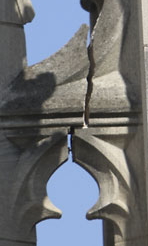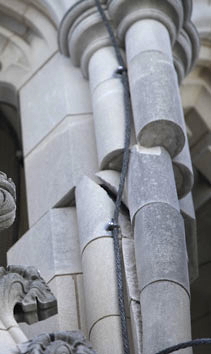
Goddard Space Flight Center, Greenbelt, Maryland 20771
ENGINEERING COLLOQUIUM
Monday, November 9, 2015 / 3:30 PM, Building 3 Auditorium



Robert Mark and Joe Alonso
"Repairing Earthquake Damage at Washington National Cathedral"
ABSTRACT -- Begun in 1909, the construction of the Washington National Cathedral was completed only in 1991. The architects of this twentieth-century cathedral sought to follow the principles of Gothic architecture as closely as possible. True load-bearing masonry structure was used rather than more common modern construction of stone veneer on a steel or reinforced concrete skeleton. Even so, the cathedral isn't composed exclusively of limestone blocks as were the early buildings. Instead, the walls are largely formed of a brick core with thick limestone facings. Along with siting on layers of silty sand and fat clay to a depth of some 100 feet before reaching shale, this mode of construction hardly creates optimum conditions for resisting earthquake.
The 5.8-magnitude tremor on August 23, 2011 wasn't huge by global standards, but punched above its weight. Geologists were struck by the way the tremor near the town of Mineral, Virginia managed to cause extensive damage in the nation's capital, 84 miles away. The Cathedral and the Washington Monument, both using tall masonry construction, were probably most affected.
The campaign of restoration of the Cathedral began almost immediately following the earthquake. It includes complete redesign of certain large-scale architectural elements such as the giant 50-foot-tall stone pinnacles atop the crossing tower. This engendered also shake-table testing performed last year at Columbia University. The many facets of the still-ongoing Cathedral restoration will be described.
SPEAKER -- Joseph Alonso, Head Stone Mason, came to the Cathedral in 1985 and worked on the construction of the West Towers until 1990. He had the honor of setting the final stone 82 years to the day when the foundation stone was set. Since then, he has supervised numerous restoration and maintenance projects on the Cathedral, and since 2011 has been heavily involved in the stabilization and repair of the earthquake damage.
SPEAKER -- Robert Mark, Professor Emeritus of Civil Engineering & Architecture at Princeton University and long-time consultant to the Cathedral, pioneered the application of modern physical and numerical modeling for the study of historic building structure. His engineering background includes developing optical modeling techniques for analysis of aerospace, deep-undersea, and nuclear-power components as well as complex building structures of reinforced concrete. He served as technical editor of the Journal of the Society of Experimental Mechanics and is a Fellow of the Society.
Colloquium Committee Sponsor: Brent Warner
Engineering Colloquium home page: https://ecolloq.gsfc.nasa.gov